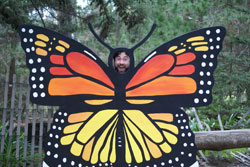Cara Faillace and Nick Lorusso making presentations at the American Society of Naturalists and at Quantitative Ecology

Cara fulfills her lifelong dream of holding an octopus
Doctoral candidates Cara Faillace and Nicholas Lorusso recently traveled with their Ph.D. advisor, Professor Peter Morin, to present their work at the 2016 meeting of the American Society of Naturalists in Asilomar, California, and then to the inaugural meeting of Quantitative Ecology at MIT (PDF), where Dr. Morin was an invited speaker.

Nick gets excited prior to his talk
Cara's research broadly focuses on interactions among native and exotic species, with a primary focus on plants and soil microbes. Her ASN presentation, titled "Strangers in a strange land: coevolution in invaded communities", focused on the effects of coevolutionary history on interactions among native and exotic species of protists. Her coevolution study is unique in its goal of understanding how species in invaded communities, as well as the invaded communities themselves, can change after hundreds of generations of biotic interactions. Cara demonstrated that biotic interactions and biological community composition can both change significantly as a result of coevolution among native and invading species, a result that has important implications globally for biological invasions. Her MIT presentation was a poster-version of the same project.

Nick and Cara rest after an afternoon of intertidal exploration
Nick's ASN talk described an experiment in which the introduction of a novel predator results in exploitation of the defensive phenotype, which in turn provides a potential explanation for the morphological changes seen in Chlamydomonas' evolutionary relatives (see figure). Subsequently, at MIT, Nick exhibited a poster reporting preliminary genomic analysis, which supports the role of colonial defense in the maintenance of gene families employed by Volvox carteri in its quest for permanent multicellularity.
Between meeting activities in Asimolar, Cara and Nick found time to explore California's rocky intertidal habitat, where they found a small octopus among other delights.
Figure caption: Left: Photos of Chlamydomonas reinhardtii (top) and Volvox carteri (bottom). Right: The proposed evolutionary lineage of the Volvocine algae Nick is exploring in his research, with the colonial defense phenotype of C. reinhardtii at its base.

March 2016


